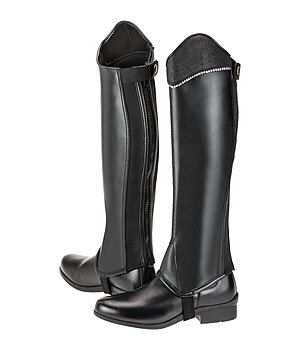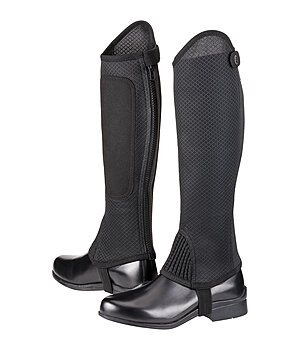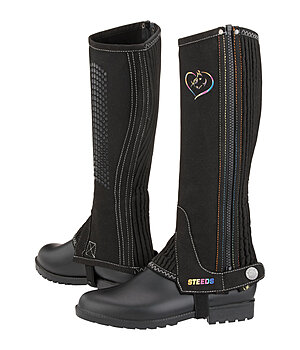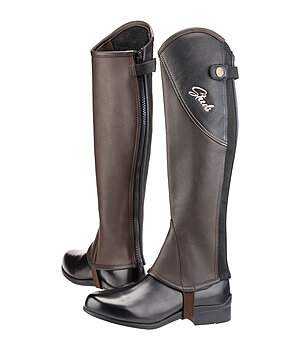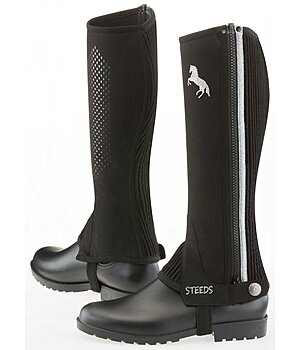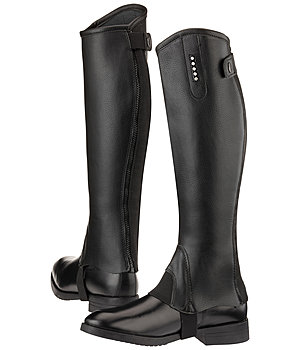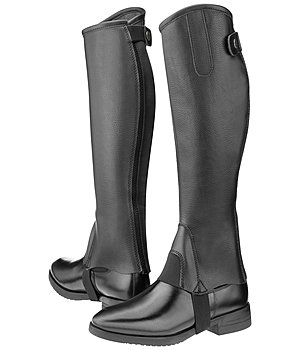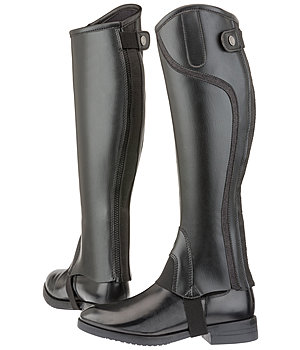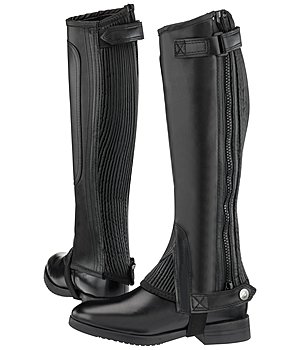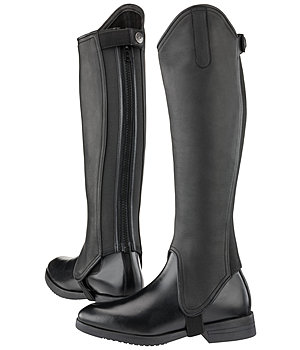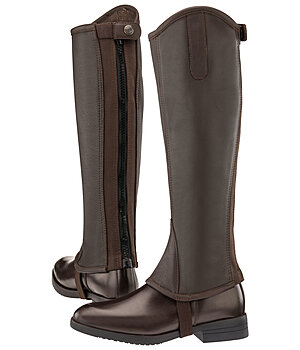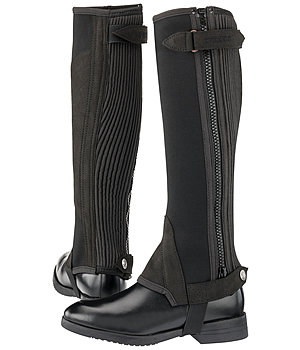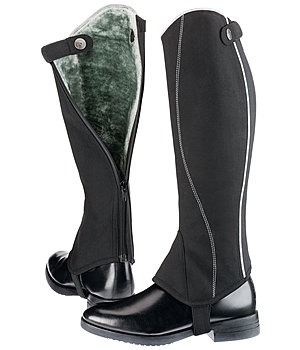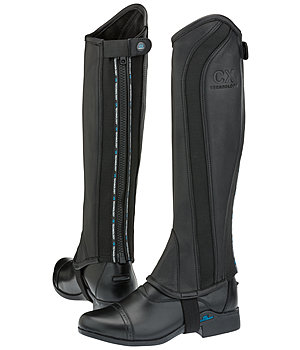Accessories and extras – what do I need for my riding boots and jodphur boots?
Half chaps and gaiters are a useful addition if you are a rider who opts for jodphur boots or riding boots with a short shaft and do not wear jodhpur breeches. In our guide, we explain the differences between gaiters and half chaps and which accessories you should also have at home for your riding boots.

Half chaps and gaiters – the perfect accompaniment to jodhpur boots
As soon as the decision for footwear with a short shaft has been made, the question of half chaps or gaiters often arises. In contrast to long riding boots with a high and stable shaft, jodphur boots in combination with half chaps offer maximum flexibility, which on the one hand brings great advantages in terms of wearing comfort at the stable, but on the other hand also requires good riding skills when it comes to a steady leg position. Nevertheless, jodphur boots with half chaps or gaiters are very popular because they are usually a little cheaper than long leather riding boots and are also a good alternative to long riding boots for those with „non-standard“ leg sizes.

Half chaps and gaiters – the differences
If you don’t want to miss out on the stability and grip of a riding boot in the saddle, but still want to enjoy maximum freedom of movement when working in the yard, you are well advised to choose half chaps and gaiters that can be quickly put on and taken off.
| Half chaps | Gaiters | |
| Material | Soft imitation leather, nylon, chloroprene rubber, genuine leather, with or without grip elements | Durable imitation or genuine leather |
| Look | Smooth or suede look, soft feel, sporty-casual, for children with prints | Elegant boot look with distinctive dressage bow |
| Wearing comfort | Very high, due to its flexibility and softness | High, resembles the comfort of a long riding boot |
| Price | Affordable | Slightly more expensive than soft half chaps |
What should I look for when buying half chaps and gaiters?
As with the purchase of long riding boots, you should determine the relevant measurements before buying gaiters and half chaps. In contrast to long riding boots, the calf height of half chaps and gaiters are measured from the middle of the ankle to just below the back of the knee. Another important measurement is the calf circumference. The tape measure is placed on the widest part of the calf.


When measuring, you should pay attention to the following things:
- Calf circumference can vary depending on the time of day and weather conditions. The legs are often swollen in the evening. Therefore, you should preferably measure the leg in the evening or afternoon or add 0.5 cm.
- The measurement should be taken standing up, and it is best to wear the breeches and riding socks that you normally wear.
- If your measurements differ from those in the size chart, choose the next size up.
When trying on, the following things should be taken into account:
- The zips and press studs should close without any problems.
- Half chaps and gaiters should end about two finger widths below the back of the knee.
- Half chaps and gaiters should fit close to the leg without squeezing the calf.
- The material should not wrinkle, as this can lead to unpleasant chafing and pressure points.
Tips for the correct fit of half chaps and gaiters
Half chaps and gaiters for you
All sorts of useful things for your riding boots and jodphur boots
To ensure that you can enjoy your riding boots and jodphur boots for as long as possible, there are a few things you can do to make them easier to care for and more comfortable to wear.
1. Care
You can find out how to care for riding boots properly in our guide. You are well equipped with the following products:
- Soft shoe brush
- Shoe care sponges (2 sponges for wet cleaning and application of care products)
- Shoe care products suitable for the material
- Soft rags
- Waterproofing agent for shoes suitable for the material
- zip spray

Don’t forget to care for your half chaps!
Please don’t forget that half chaps and gaiters also need care. The care routine corresponds to the usual shoe care. Please use care products that are suitable for the material of your half chaps!
How do you take off your jodphur boots?
What is almost impossible with long riding boots is something many riders do for convenience with riding boots and Jodphur boots – taking them off by using the other boot to hold on to the heel and push your way out of the boot. Everyone knows the concept when things have to be done quickly in everyday life. But especially with riding boots and jodhpur boots made of leather or synthetic leather, the material is frequently damaged by the friction in the heel area.
With riding boots or jodphur boots with laces, you should always loosen the laces generously when you want to take them off. This is usually enough to comfortably slip the boot off with your hand.
If the fit is tight, it is recommended to use a bootjack, as with long riding boots. This protects the material in the long run and is also back-friendly.
The shoehorn – kinder to your back and the shoe
You can also do a lot of things wrong when putting on shoes. Slipping them on „just like that“ puts a lot of strain on the back of riding boots and jodphur boots. Use a shoehorn to prevent the material from deforming and wearing out.

2. Wearing comfort & fit
There are numerous products available to optimise the fit and comfort of riding boots and jodphur boots. From inserts for fit problems in the heel area to soles made of particularly shock-absorbing or warming materials, you will find a wide variety if the boot should ever pinch.
3. Spare parts
Care is essential to protect the material of your riding boots and jodphur boots. Laces and zips in particular are among the typical areas of the boots that are subject to wear and tear. In the case of lace-up styles, it may be necessary to replace the laces after a long period of use. The inner soles also feel rather „worn out“ after a certain time, absorb unpleasant foot odours and can also become a breeding ground for fungi and bacteria if not dried and stored properly. Therefore, regular replacement after 6 to 12 months is recommended here as well.
4. Storage
There are a number of things to consider when storing riding boots and jodphur boots. Leather boots in particular react very sensitively to certain external factors during storage.
These include:
- Moisture
- Dirt
- Temperatures
- Exposure to sunlight
When storing your riding boots, make sure that you choose a dry, clean place that is protected from light and ideally offers constant room temperatures. For example, if you are storing your winter riding boots and long winter riding boots for a longer period of time, you should first allow the boots to dry thoroughly (also from the inside). You should also give them a thorough care before „mothballing“ them, because stubborn dirt can make the material brittle in the long run. Shoetrees or crumpled newspaper will preserve the shape of your riding boots.
For transportation from home to the stable, a rider’s rucksack is recommended, in which you can not only store riding boots, half chaps etc., but also a riding hat, gloves and other riding accessories.




